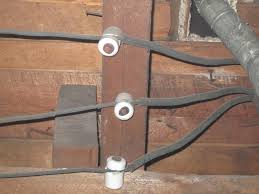Knob and Tube Electrical Wiring

When looking to purchase an older home keep an eye out for knob and tube electrical wiring. You may be able to spot this in an unfinished basement or attic.
Knob and tube is a type of branch electrical wiring that was installed in older homes (usually early 1900's), considered substandard by present standards. The insulation becomes brittle with time and may be a safety hazard. If the wiring is covered by insulation (like in an attic) it could overheat and cause a fire. Circuits hooked into this type of wiring are usually not grounded. While knob and tube wiring is normally functional I recommend upgrading and rewiring. Also, many insurance companies may have restrictions concerning knob and tube wiring.
Facts About Knob-and-Tube Wiring:
How Knob-and-Tube Wiring Works: K&T wiring consists of insulated copper conductors passing through lumber framing drill-holes via protective porcelain insulating tubes. They are supported along their length by nailed-down porcelain knobs. Where wires enter a wiring device, such as a lamp or switch, or were pulled into a wall, they are protected by flexible cloth or rubber insulation called "loom."
Problems Associated with K&T Wiring:
Compared with modern wiring insulation, K&T wiring is less resistant to damage. K&T wiring insulated with cambric and asbestos is not rated for moisture exposure. Older systems contained insulation with additives that may oxidize copper wire. Bending the wires may cause insulation to crack and peel away. K&T wiring is often spliced with modern wiring incorrectly by amateurs. This is perhaps due to the ease by which K&T wiring is accessed.
Building Insulation: K&T wiring is designed to dissipate heat into free air, and insulation will disturb this process. Insulation around K&T wires will cause heat to build up, and this creates a fire hazard. The 2008 National Electrical Code (NEC) requires that this wiring system not be covered by insulation. Specifically, it states that this wiring system should not be in hollow spaces of walls, ceilings and attics where such spaces are insulated by loose, rolled or foamed-in-place insulating material that envelops the conductors. Local jurisdictions may or may not adopt the NEC’s requirement.
K&T Wiring and Insurance: Many insurance companies refuse to insure houses that have knob-and-tube wiring due to the risk of fire. Exceptions are sometimes made for houses where an electrical contractor has deemed the system to be safe. Advice for those with K&T wiring:
Prospective home buyers should get an estimate of the cost of replacing K&T wiring. They can use this amount to negotiate a cheaper price for the house.
Looking for a Connecticut Home Inspector? Contact Allied Home Inspections LLC - "Inspected Once, Inspected Right!"
Knob and tube is a type of branch electrical wiring that was installed in older homes (usually early 1900's), considered substandard by present standards. The insulation becomes brittle with time and may be a safety hazard. If the wiring is covered by insulation (like in an attic) it could overheat and cause a fire. Circuits hooked into this type of wiring are usually not grounded. While knob and tube wiring is normally functional I recommend upgrading and rewiring. Also, many insurance companies may have restrictions concerning knob and tube wiring.
Facts About Knob-and-Tube Wiring:
- It is not inherently dangerous. The dangers from this system arise from its age, improper modifications, and situations where building insulation envelops the wires.
- It has no ground wire and thus cannot service any three-pronged appliances.
- While it is considered obsolete, there is no code that requires its complete removal.
- It is treated differently in different jurisdictions. In some areas, it must be removed at all accessible locations, while others merely require that it not be installed in new construction.
- It is not permitted in new construction.
How Knob-and-Tube Wiring Works: K&T wiring consists of insulated copper conductors passing through lumber framing drill-holes via protective porcelain insulating tubes. They are supported along their length by nailed-down porcelain knobs. Where wires enter a wiring device, such as a lamp or switch, or were pulled into a wall, they are protected by flexible cloth or rubber insulation called "loom."
Problems Associated with K&T Wiring:
- Unsafe modifications are far more common with K&T wiring than they are with Romex and other modern wiring systems. Part of the reason for this is that K&T is so old that more opportunity has existed for improper modifications.
- The insulation that envelopes the wiring is a fire hazard.
- It tends to stretch and sag over time.
- It lacks a grounding conductor. Grounding conductors reduce the chance of electrical fire and damage to sensitive equipment.
- In older systems, wiring is insulated with varnish and fiber materials that are susceptible to deterioration.
Compared with modern wiring insulation, K&T wiring is less resistant to damage. K&T wiring insulated with cambric and asbestos is not rated for moisture exposure. Older systems contained insulation with additives that may oxidize copper wire. Bending the wires may cause insulation to crack and peel away. K&T wiring is often spliced with modern wiring incorrectly by amateurs. This is perhaps due to the ease by which K&T wiring is accessed.
Building Insulation: K&T wiring is designed to dissipate heat into free air, and insulation will disturb this process. Insulation around K&T wires will cause heat to build up, and this creates a fire hazard. The 2008 National Electrical Code (NEC) requires that this wiring system not be covered by insulation. Specifically, it states that this wiring system should not be in hollow spaces of walls, ceilings and attics where such spaces are insulated by loose, rolled or foamed-in-place insulating material that envelops the conductors. Local jurisdictions may or may not adopt the NEC’s requirement.
K&T Wiring and Insurance: Many insurance companies refuse to insure houses that have knob-and-tube wiring due to the risk of fire. Exceptions are sometimes made for houses where an electrical contractor has deemed the system to be safe. Advice for those with K&T wiring:
- Have the system evaluated by a qualified electrician. Only an expert can confirm that the system was installed and modified correctly.
- Do not run an excessive amount of appliances in the home.
- Where the wiring is brittle or cracked, it should be replaced. Proper maintenance is crucial.
- K&T wiring should not be used in kitchens, bathrooms, laundry rooms or outdoors. Wiring must be grounded in order to be used safely in these locations.
- Rewiring a house can take weeks and cost thousands of dollars, but unsafe wiring can cause fires, complicate estate transactions, and make insurers skittish.
- Homeowners should carefully consider their options before deciding whether to rewire their house.
- The homeowner or an electrician should carefully remove any insulation that is found surrounding K&T wires.
Prospective home buyers should get an estimate of the cost of replacing K&T wiring. They can use this amount to negotiate a cheaper price for the house.
Looking for a Connecticut Home Inspector? Contact Allied Home Inspections LLC - "Inspected Once, Inspected Right!"

